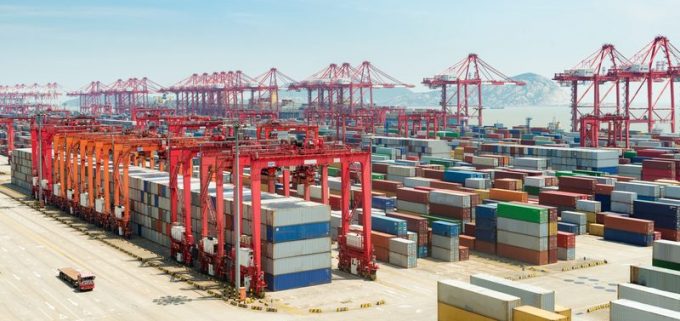Container spot rates have peaked as all major trades see prices fall
There was more evidence in this week’s container port freight markets that peak prices on ...
TFII: SOLID AS USUALMAERSK: WEAKENINGF: FALLING OFF A CLIFFAAPL: 'BOTTLENECK IN MAINLAND CHINA'AAPL: CHINA TRENDSDHL: GROWTH CAPEXR: ANOTHER SOLID DELIVERYMFT: HERE COMES THE FALLDSV: LOOK AT SCHENKER PERFORMANCEUPS: A WAVE OF DOWNGRADES DSV: BARGAIN BINKNX: EARNINGS OUTODFL: RISING AND FALLING AND THEN RISING
TFII: SOLID AS USUALMAERSK: WEAKENINGF: FALLING OFF A CLIFFAAPL: 'BOTTLENECK IN MAINLAND CHINA'AAPL: CHINA TRENDSDHL: GROWTH CAPEXR: ANOTHER SOLID DELIVERYMFT: HERE COMES THE FALLDSV: LOOK AT SCHENKER PERFORMANCEUPS: A WAVE OF DOWNGRADES DSV: BARGAIN BINKNX: EARNINGS OUTODFL: RISING AND FALLING AND THEN RISING

Container freight rates on the main east-west trades continued at elevated levels this week, although some routes began to see pricing tail off.
Today’s reading of the Freightos Baltic Index shows the spot rate between Asia and the US east coast slip to $7,358 per 40ft, down from $7,477 per 40ft last week.
And transatlantic shippers saw spot rates on the North Europe-US east coast trade, which had doubled since beginning of April, decline to $4,076 per 40ft, from $4,274 last week.
Meanwhile, the transpacific trade from Asia to the US west coast saw the FBX spot rate effectively flat, at $5,379 per 40ft.
However, for European shippers and forwarders on ex-Asia trades, it was another week of pain.
The FBX spot rate for Asia-North Europe climbed 9.1%, to reach $9,871 per 40ft, while Asia-Mediterranean climbed 6.1%, to $10,214 per 40ft.
Meanwhile, Drewry’s World Container Index’s (WCI) reading of the Shanghai-Rotterdam leg stood at $10,174 per 40ft, a 3% gain on last week.
The reality, of course, is that many customers are paying far more than these rates, as carriers are increasingly levying extra charges such as space guarantees, which can easily reach $1,000 per box.
“The actual price for a 40ft high-cube ex-China to the UK is now $13,000-$14,000, and I think it is possible we will reach $15,000,” one UK forwarder told The Loadstar this week.
“The rates are too high,” he added. “We are now seeing shippers cancel orders because the freight rates cancel out their margins, and the whole situation has become really worrying, because I think this will lead to business failures and a lot of pain for the general economy down the road.”
And while the transpacific and transatlantic might have been relatively calm, in terms of price movements, last week, next week is expected to see a new raft of general rate increases on those trades, and spot rates could soar once more.
Xeneta founder and chief executive Patrik Berglund noted yesterday: “After years of fluctuating fortunes, the carriers are determined to seize on current opportunity, manoeuvring to exploit huge consumer demand and increased online retail with new strategic moves.
“For example, Hapag-Lloyd now plans a $3,000 per 40ft GRI on Far East-US trades from mid-June, and with fundamentals so much in their favour, there’s a good chance they’ll achieve some level of implementation.”
Similarly, transatlantic shippers are preparing a new set of GRIs and/or peak season surcharges, ranging from $500-$2,500 per teu.
The high spot rates also continue to have a material impact on shippers and forwarders looking for longer term contracts, Mr Berglund said.
“A lack of equipment and the ongoing ramifications of coronavirus, added to unforeseen factors such as the blocking of the Suez Canal, have squeezed supply chains, pushing capacity to bursting point.
“This leaves stressed shippers facing increasingly one-sided negotiations and, even when contracts are signed, the potential of rolled cargo and broken agreements as operators take advantage of massively lucrative spot rates.
“With carriers blanking sailings to manage capacity added to continuing high demand and reduced retail inventories, it’s difficult to see the prospect of any immediate rate relief on the horizon,” he said.
Comment on this article